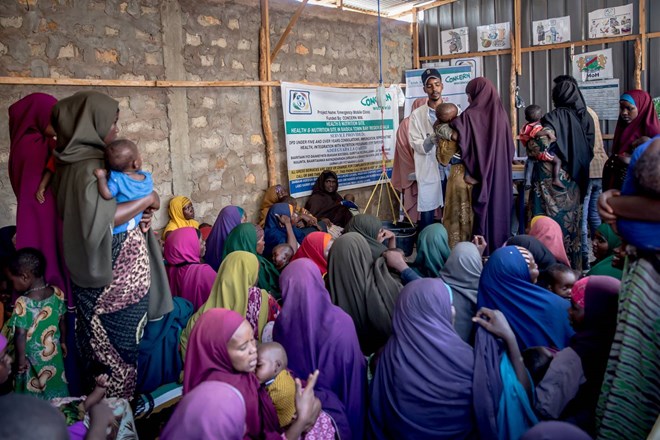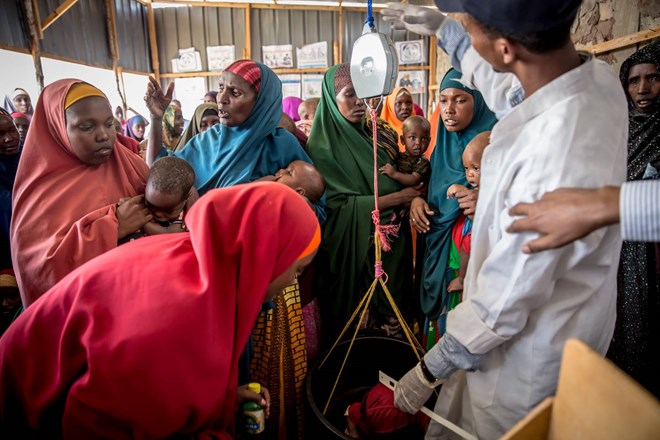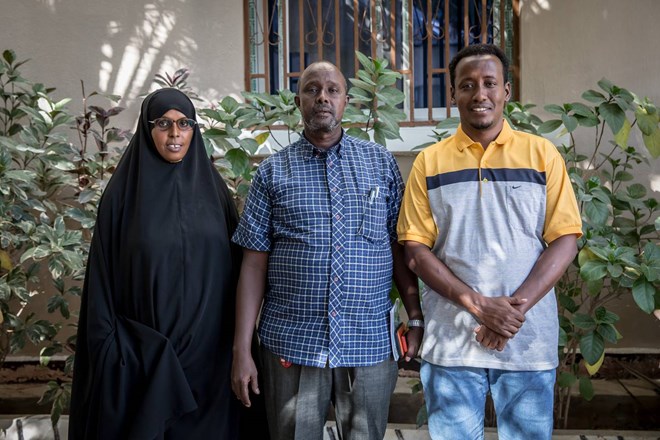
Thursday January 5, 2023
By Sally Hayden
As Somalis suffer the country’s worst drought in 40 years, medical workers warn of the long-term physical damage malnutrition is doing to children
A child is screened for malnutrition at a health clinic in Baidoa, Somalia. Photograph: Sally Hayden
Fatuma Hassan, a secondary schoolteacher in Somalia’s capital Mogadishu, notices when her students are hungry. “They can’t pay attention,” she says. But, despite the lack of food, they are keen to attend class.
“They see it as important, they say in the future it will help. Now they are poor but in the future they can help their family if they learn. They are trying to struggle now for education.”
Still, the devastating current drought has caused chaos in Hassan’s workplace. New students, whose families have joined the masses of displaced people in Mogadishu, constantly turn up, swelling class sizes to as high as 80. Others who used to be regular attendees miss two or three days in a row. “If you ask them [where they were] they will tell you they go out to look for food to eat because the parents don’t have work,” Hassan says.
As Somalis suffer through the country’s worst drought in 40 years, medical workers warn of the long-term physical damage malnutrition is doing to children, while teachers say hunger is affecting their education and future prospects.
About 5.6 million Somalis are in so-called “crisis” levels of food insecurity. The UN estimates that 1.8 million children are acutely malnourished. Between January and November 2022, at least 1,049 children died in health centres and hospitals of hunger-related causes, according to UN figures. Aid workers warn that many more are dying unrecorded, without ever accessing treatment.
Experts say the level of child mortality required for a famine to be declared have been reached in two parts of Somalia, though other technical requirements have not been met. This means that more than four children per 10,000 are dying every day in areas of the capital city, Mogadishu, and Baidoa, another epicentre of the drought response.
Women wait to have their children screened for malnutrition at a health clinic in Somalia. Photograph: Sally Hayden
Somali children who escape death may still be affected for life.
Nutritionists say that the first 1,000 days, from the time a child is conceived to their second birthday, are key in terms of making sure they get the nutrients needed. Deficiencies experienced at that point can impact both their physical growth and intellectual development, with repercussions for the rest of their life.
“Stunting early in a child’s life can cause irreversible damage to cognitive development and has educational, income and productivity consequences that reach far into adulthood,” the World Bank says in its nutrition overview.
In a health centre in the Salaamey Idale camp for displaced people in southern Baidoa, midwife Zainab Aanay Ali sees first hand the impact of malnutrition on pregnant women.
“Anaemia has increased recently as a result of the drought because most of the mothers seem to be malnourished,” she says. “Most of the mothers are not getting food and whatever they are getting is not nutritious.”
Zainab Aanay Ali, a midwife in a camp in southern Baidoa, said more pregnant women than usual are coming to her suffering from anemia, which puts them in danger. Photograph: Sally Hayden
A stillborn child was recently delivered to an anaemic mother in the clinic. “Anaemia is a very serious complication for pregnant mothers, it makes her very weak, and the baby will be weak. If the mother bleeds during delivery she’s likely to die, and the child is likely to die.”
In the open air outside the delivery ward, children are being weighed, and their upper arms measured, to see if they qualify for food supplements. Within a few hours, 15 children are found to be malnourished and in need of nutritional support.
A child is screened for malnutrition at a health clinic in Baidoa, Somalia. Photograph: Sally Hayden
Among them is Zacharia, the 18-month-old son of Fardowsa Mohamed. He has not started walking, Fardowsa explains. “He is very weak. When he tries to walk he just falls over.”
Zacharia’s assessment reveals that he weighs just 6kg; the World Health Organisation’s child growth standards say a child of his age should weigh nearly double that.
This is Zacharia’s first time being enrolled in a nutrition programme, and he will receive supplements for three months. But Fardowsa says it will be a challenge not to share them with her other nine children. “The rest of the family have no food,” she says. “The father has no work. Our food insecurity is very severe. Because of food insecurity, it’s very difficult to give [food to] one [child] and leave the others [with nothing] but I will try. It would have been good if they would give us something for the rest of the family.”
The family came to Baidoa two months ago, abandoning their home 30km away. “I was keeping animals, especially cows and goats, and they all perished,” Fardowsa says. “We finished our storage of food and we came for survival.”
While many assessments focus on the impact of starvation on children under five, who are particularly vulnerable medically and physically, disruptions to their education will also affect a child for life.
Due to demand, the Ali Hussein primary and secondary school, where Fatuma Hassan works, runs two shifts for two different sets of children: 7.30am-12.30pm, and 1.30pm-5pm.

Women wait to have their children screened for malnutrition at a health clinic in Baidoa, Somalia. Photograph: Sally Hayden
 A child is screened for malnutrition at a health clinic in Baidoa, Somalia. Photograph: Sally Hayden
A child is screened for malnutrition at a health clinic in Baidoa, Somalia. Photograph: Sally HaydenThere are 2,228 students in total, 59 teachers, and three administration staff, says principal Abdulkadir Mohamed. The school is free to attend. In the past month, admission closed because of the large number of new students who were showing up and asking for an education.
“Mostly our students are the poor extreme students from the displaced areas,” says Abdulkadir, explaining that the drought has swelled overall numbers but also badly affected attendance. About 400 failed to show up for the latest midterm exam. “We know [they’re hungry] because they come from IDP [internally displaced people] camps. They are poor. They are different from other students.” He says the level of malnutrition is clear, and many students “don’t come to school regularly. If you ask them [why] they say they’ve been doing shoe-shining at one shift and coming to school the other”.

Fatuma Hassan and Abdulkadir Mohamed, who work in Mogadishu's Ali Hussein primary and secondary school, and Mohamed Ali, deputy education programme manager for Concern Worldwide. Photograph: Sally Hayden
The need for food aid has created conundrums for teachers. In the past, administrators at the Ali Hussein primary and secondary school were part of an NGO feeding project, Abdulkadir says. Provisions included porridge, maize, sorghum and rice, but teachers had to cook and prepare the food, and that was so time consuming that lessons were badly affected. The school’s administrators requested dry food, or something that was already prepared, to distribute instead, but it was not forthcoming. “We stopped because it impacted the education,” says Abdulkadir.
“[But students] cannot learn, because they are hungry. They want to be familiar with literacy and numeracy. They want to learn but their life is difficult,” the principal continues. Despite the challenges, last year 93 students graduated from secondary school, he adds, with just 10 failing their exams.
“The children want to learn and the parents want them to learn,” says Mohamed Ali, deputy education programme manager for Irish charity Concern Worldwide, which supports the school with books and teaching materials, along with other aids.
Nevertheless, he says, the students who make it are the minority. “In Somalia, 61 per cent of children aged 6-24 are out of school. Forty-Five per cent have never attended school and 15 attended but dropped [out],” Ali says.